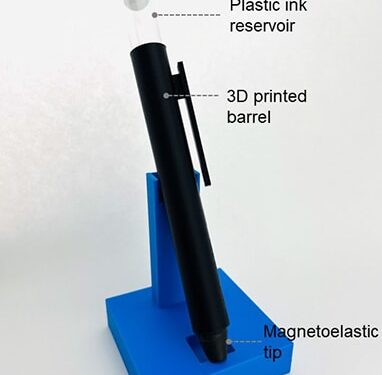Biomedical engineers have developed an artificial intelligence (AI)–enhanced pen for personalized handwriting analysis to aid in the early diagnosis of Parkinson’s disease (PD).
In a small pilot study, the “diagnostic pen” accurately recorded handwriting signals, and neural network-assisted analysis successfully distinguished PD from non-PD handwriting with greater than 95% accuracy.
“Further validation through large-scale human studies is necessary to confirm the diagnostic effectiveness of the pen,” first author Guorui (Gary) Chen, PhD candidate, Department of Bioengineering, University of California, Los Angeles, told Medscape Medical News.
“While significant research and development are still required, we are optimistic about its potential for future use in both clinical and home settings,” Chen said.
The study was published online on June 2 in Nature Chemical Engineering.
High Unmet Clinical Need
PD is one of the fastest-growing neurodegenerative disorders, affecting over 10 million people worldwide. PD is typically diagnosed through subjective observation of motor symptoms like tremors and rigidity.
However, this approach lacks objective precision and is inaccessible in many regions due to a shortage of neurologists and expensive diagnostic methods. A quantitative, low-cost, and accessible method for PD diagnosis in large populations remains an unmet need.
Handwriting, which requires fine motor control, is affected early in PD and could help fill this need.
The pen Chen and colleagues developed comprises a soft magnetoelastic silicone tip embedded with magnetic particles and a reservoir of ferrofluid ink. These components convert handwriting motions — both on paper and in the air — into high-fidelity, analyzable electrical signals.
In the pilot study involving three patients with PD and 13 healthy participants, the diagnostic pen accurately captured biometric handwriting data, and neural network-assisted analysis distinguished PD from non-PD handwriting with 96.22% accuracy.
“This diagnostic pen technology could offer an innovative pathway to complement existing PD diagnostic methods by supporting a crowd-sourced approach, facilitating early detection in large populations,” Chen and colleagues wrote.
It may be particularly beneficial for individuals who may not yet recognize that they could have PD and for those in resource-limited regions where access to medical diagnostics using chemical biomarkers is scarce, they added.
Chen cautioned that the pilot study involved a limited cohort, including patients who had already been diagnosed with PD by physicians and were subsequently enrolled in the study.
“Future work could focus on evaluating the pen’s potential for early screening in broader populations through larger-scale human studies, which may open the door to both physician-directed use and patient-initiated assessments,” Chen told Medscape Medical News.
Elegant Tool and Exciting Concept
Reached for comment, Shaheen Lakhan, MD, neurologist and researcher based in Miami, said the diagnostic pen is “a clever fusion of materials science and signal processing, but it fits into a broader movement in neurology, using fine motor signatures as digital biomarkers. We already see this with keystroke dynamics, touchscreen taps, and voice analysis. In that context, this pen is not a breakthrough but a thoughtful variation on a theme.”
“What makes it stand out is its self-powered, screenless design. It captures both on-surface and in-air movements without the need for apps, tablets, or electricity. That simplicity could prove useful in rural clinics, low-resource environments, and aging populations less comfortable with digital technology. This pen may not revolutionize diagnosis, but it democratizes access,” Lakhan told Medscape Medical News.
Still, he said, the underlying question remains — what do we gain from earlier
diagnosis?
“Right now, we have no approved disease-modifying therapy for Parkinson’s, especially in the asymptomatic or prodromal stages. Even if a pen flags subtle motor changes, clinical management does not fundamentally change. However, it enables earlier counseling, monitoring, and research enrollment in the quest for disease-modifying therapy,” Lakhan said.
“It’s an elegant tool. But whether it’s truly useful will depend not just on how early it detects disease but whether we’re ready to act on what it finds,” Lakhan noted.
He said the promise is also tempered by the fact that the study involved only three patients with PD.
“While the early data are promising, the clinical utility, real-world usability, and human factors remain largely untested. Without broader validation, this remains a prototype in search of a clinical pathway,” Lakhan said.
“As a neuroscientist, I do find the concept exciting. Handwriting is a remarkably rich motor task, involving basal ganglia circuits, proprioception, and executive planning. Capturing these micro-signals in real time could open doors beyond Parkinson’s, into cognitive disorders, neuromotor decline, and more. The real promise isn’t the pen, it’s what we can eventually do with the data,” Lakhan added.
The study was funded through grants and awards to the investigators. Chen and a co-author are inventors on a provisional patent application related to the development and application of the diagnostic pen, filed by the University of California, Los Angeles. Lakhan had no relevant disclosures.
Source link : https://www.medscape.com/viewarticle/ai-pen-accurately-diagnoses-early-parkinsons-handwriting-2025a1000eyw?src=rss
Author :
Publish date : 2025-06-04 08:19:00
Copyright for syndicated content belongs to the linked Source.














